Animation
World Magazine, Issue 1.11, February 1997
The Changing Winds of Korean Animation
by Chung-bae Park
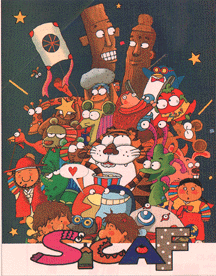 Official
poster for the Seoul International Cartoon and Animation Festival (SICAF).
Official
poster for the Seoul International Cartoon and Animation Festival (SICAF).
In December, South Korea, known as the "Miracle
on the Han River" and a major automobile and semiconductor exporter,
joined the OECD. Today, however, the most important topic of conversation
concerns the future of Korea's entertainment industry. And animation is
the center of that industry. Nineteen ninety-five will be remembered as
a turning point for Korean animation: it was the year when the world's
second channel devoted exclusively to animation was established and when
Korea first played host to the Seoul International Cartoon & Animation
Festival (SICAF). These events took place against a background of the increased
production of animated features, all of which signaled the start of a new
phase in Korea's animation industry.
From Subcontracting to Planning
Korean animation nominally began with a commercial for Lucky Toothpaste
in 1956. But, it is usually agreed that it really began with the production
of Hong Gil Dong (1967), the country's first animated feature by
Shin Dong Woo of the Shin Dong Hyun brothers (Korea's answer to Walt and
Roy Disney). The film's success sparked public interest in Korean animation.
Though after one more film, the Shin brothers' success ended due to a dispute
with their distributor. In the early 1970s, the market for Korean animation
rapidly shrank as the country was flooded with foreign animated films and
TV shows.
Korea's animation industry acquired the unique distinction of being dominated
by feature films. Most American and Japanese TV series were being animated
in Korea, but local broadcast outlets could not afford to make such shows
themselves. As a result, Korea became subordinate to the American and Japanese
oligopoly.
 View outside of theater at SICAF.
View outside of theater at SICAF.
A Decade of Subcontracting
The 1970s was the decade of subcontracting. Korean animators, because of
their low wages and high skills, were in high demand by American and Japanese
producers. While subcontracting greatly expanded the Korean animation industry,
it also gave it a bad name, as it seemed to demonstrate a lack of creativity
and planning.
Before the 1988 Seoul Olympics, as a result of cultural reform, there arose
a demand for domestically made animated TV series. The demand was finally
met when Korea's two major broadcasting stations, KBS and MBC, showed the
first locally-made animated series: Wandering Gga Chi and Go
On Running Hodori. The following year,Wonder Kiddy 2020 sparked
interest on the international scene.
While both subcontracting and domestic production continued to coexist
after 1988, some studios began to enter into co-production deals with Japanese
and American companies, enabling Korea to begin entering the international
animation market. Disney's success in 1992, spurred a revival the following
year of local animated features for the first time in seven years.
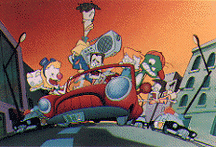 Dinosaur Dooly (1996).
Dinosaur Dooly (1996).
What Inspired These Changes?
The first factor in changing Korea's animation industry was that the country's
major industrial companies changed their attitude about investing for the
21st century. With the worldwide entertainment industry expected to become
highly profitable, they became eager to enter the field, which of course
included animation!
Jeiljedang invested in DreamWorks SKG and began to produce animation through
JCOM. The Dong Yang Group established the Tooniverse cable channel, while
such industrial giants as Samsung, Hundai, and DaeWoo are also entering
the fray.
Second, there were changes in the structure of the animation industry itself.
During the 1970s and 1980s, Korea had been relied on as a source of cheap
labor. When its work force became more expensive and Korea started to shun
low tech industries, it started to lose subcontracting work to Southeast
Asia and China. It is a situation that threatens the livelihood of the
some 20,000 people employed at 450 studios. These workers, along with the
major industrial companies, provided the basis for a transition from subcontracting
to indigenous production. This resulted in development and planning departments
being set up in the larger studios.
Third, changes occurred because of the new expectations engendered by the
success of Disney animated features and the global spread of Japanese animation.
Disney's success, in particular, allowed Korea to dream of animation as
being a viable industry in the same league as automobiles and semiconductors.
And it was the success of nearby Japan's animation industry that supported
that dream.
 From the Edges
Towards the Center
From the Edges
Towards the Center
These structural changes resulted in many changes in the Korean animation
industry itself. Nineteen ninety-five, the first year of planned animation,
proved to be the turning point. The most important change, though, was
the birth of the Dong Yang Group's Tooniverse. (Until then, Dong Yang had
been a leading confectionery and finance company.) The laws governing Korean
cable television demanded that 30% of programming be locally made, a mandate
that was easily fulfilled by animation. As a result, along with co-ventures
in such related industries as cartoons and games, the animation market
started to take off.
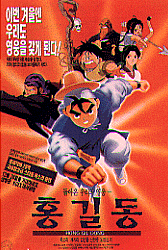 1995 version of Shim brothers'Hong
Gil Dong.
1995 version of Shim brothers'Hong
Gil Dong.
Another important change was the increase in the
production of in-house productions and the continuing challenge of making
feature-length films. The number of animated features increased steadily
(one each in 1993 and 1994, and three in both 1995 and 1996), as did the
number of TV shows (five to six new series a year between 1994 and 1996).
However, with the exception of Little Dinosaur DoolyDecember 1996,
most indigenous animated productions have not been successful. This shows
that, despite Korea's demonstrated technical proficiency in animation,
its productions lack the creativity characteristic of Korean cultural products.
For 1997, it is expected that the development and production of original
material will provide new opportunities to incorporate Korean styles, characters
and plots, resulting in films of the same quality as Dooly. Korean
animation is ready to compete in the international marketplace through
original TV series and international co-productions.
As to computer animation, Korea, which was once a desert, has made significant
progress, which started withWa Bull in 1991. The progress
eventually resulted in having films entered into competition at last year's
Hiroshima Animation Festival; in addition, this technology is now being
used in movies, commercials and other areas of film and television.
Due to the animation boom, a number of animation schools were established.
Thus, the number of animation courses has increased from only one prior
to 1995, to four in 1995, and eight last year. These well-educated directors,
animators and planners will ensure that the expansion of the local industry
will not be short-lived and as such will provide the most powerful force
in Korean animation.
Recent developments in animation parallel the country's industrial policy,
which is noted for government working hand-in-hand with the private sector.
The most impressive example of this collaboration was SICAF, where attendance
was over 300,000, once again illustrating the great interest in locally-made
product. The Korean government also sees animation as the most competitive
industry for the 21st century. To demonstrate their confidence, it has
provided tax breaks by changing animation's industrial classification and
providing services to producers--two changes which clearly demonstrates
the government's commitment to the field.

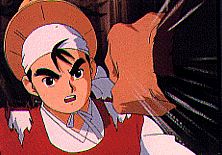
1995 version of Shim brothers'Hong Gil
Dong.
Despite all the changes and progress made by Korea's
animation industry, it continues to remain on the periphery of the international
subcontracting system. The winds of change are blowing, but nobody knows
whether they will turn into a typhoon or simply fade away. Some speculate
that the future of Korean animation is not bright, because of the industry's
inability to plan, investors who demand immediate results, and the overwhelming
power of Disney and Japanese companies.
However, with substantial investment from the country's industrial giants,
the increased interest by the public, and a new cadre of highly trained
animation artists, the Korean animation industry now has the potential
to change.
Animation in Korea can perhaps best be compared to country's shoe industry.
During the 1970s and 1980s, Korean labor was a vital factor in subcontract
shoemaking, a role now assumed by China and Southeast Asia. Recently, a
slogan used by a local shoe manufacturer gained considerable popularity:
"To conquer or be conquered." This motto perfectly expresses
the critical situation of today's Korean animation industry.
Chung-Bae Park is Vice President of MICOM , in Korea, and whose book,
Animation Story, was published last year. An experienced animation
producer, he was until recently President of Seiyong Anitel.
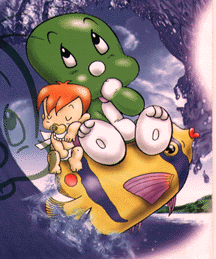
Dinosaur Dooly (1996).
Back to the Table of Contents
Feedback?
Past Issues
![]()
![]()
![]()
![]()
![]()
![]()
[about | help
| home | info@awn.com
| mail | register]